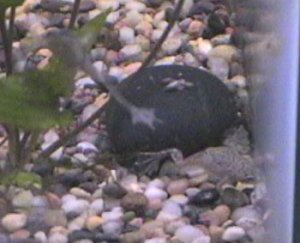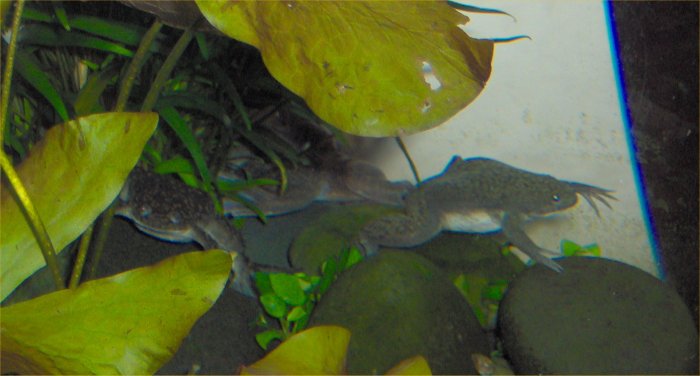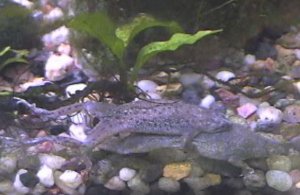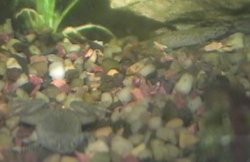 |
 |
|
|

Last Updated: 2/21/14


African Clawed Frogs (ACF's)
African Dwarf Frogs (ADF's) - including feeding and breeding
My African Dwarf Frogs - story and photos

African clawed frogs (Xenopus species) or ACF's are suited for life indoors in aquariums. They are not a pond frog (except in Africa) but I am mentioning them here for those who keep them in aquariums. They have interesting behavioral and reproductive characteristics. African clawed frogs, such as Xenopus laevis, commonly sold as a "Grow-A-Frog," grow to about 5 inches. They eat things live black worms, small live fish, and really whatever they can fit in their mouths! African clawed frogs prefer a temperature around 75 degrees F. Being fully aquatic, they do not require a haul out site. They are pudgy with sharp rear claws. There is an albino form commonly sold. Because I do not know much about them and have never kept them, I refer you to the aquarium frog links.
African dwarf frogs (ADF's for short), or Hymenochirus boettgeri, are often confused with African clawed frogs. Unlike the above, they only grow to up to 1.5 inches or so. Due to their small size, they have a lower propensity to eat small fish in their tank. I even had fry in with my ADF's and never saw them try to eat the fry. Like the Xenopus species, ADF's are fully aquatic. Unlike the African clawed frogs, they have obvious webbing between their front toes and small eyes. They prefer to eat small live foods by scent. African dwarf frogs will also eat frozen (or live) bloodworms, brine shrimp, and daphnia. While some people report them eating fish food flakes, others say that happens rarely. In tanks with fish, the frogs can be given sinking fish foods to eat. Some may nibble algae- and plant-based foods but more luck might be had with meat-based sinking foods like shrimp pellets. My ADF's ate live blackworms as their main food. See below for more on feeding. Their preferred temperature is about 77 degrees F with a pH of 7.2 to 7.6. For more information on these neat frogs, visit the links section.
ADF's do best with heaters keeping their water above 70 degrees F as they like it somewhat warm. Even though they can gulp air at the surface, they do need to get oxygen through their skin so mild aeration and filtration is a good idea.
Gail informed me that she put a ghost shrimp in her tank with two ADF's, and the shrimp caught one frog and bit off his leg! So, it would be wise to avoid adding large crustaceans to tanks with small frogs. I did have five shrimp with my ADF's but they were small shrimp and not as "grabby" as ghost shrimp.
Feeding:
(Note: Also see above for more on feeding African dwarf frogs.)
Most amphibians only eat live foods. Aquarium frogs also prefer live foods but will eat some non-living foods. If there is a choice, they will go for live foods first. African dwarf frogs (ADF's) love small worms and insects such as blackworms, bloodworms (insect larvae of a species of midge), mosquito larvae, brine shrimp (not so much a favorite), daphnia, and so on. If the frogs find something they want to eat, the ADF's will do their bounce and suck move. When I put in live blackworms daily, the frogs ambled over in their stealth mode. Then, they did a little hop while opening their mouths. The suction that was created sucked up the worms, and the frogs chomped away, very satisfied. ADF's are attracted by smell and movement. They look for movement first but if they are hungry enough, they may suck up something that smells good but is not alive. As a side note, my ADF's lived with small fish and shrimp and never tried to eat them. But, they did once bounce/suck on a large false Siamese algae eater who probably wondered what in the world was going on! One person told me a large ghost shrimp ate their ADF's leg off. If live foods cannot be obtained, then frozen ones are the next best choice. Mine have eaten frozen bloodworms with relish, and many frog lovers report these are favorites.
Many keepers of ADF's feed manufactured foods, sometimes exclusively. I too offered two brands of frog pellets but never actually saw my frogs eat them. Others say they do since that is all that they offer. The two foods I have are "HBH Frog & Tadpole Bites" and "Jurassi Diet Newt & Aquatic Frog Food." Both contain mostly krill and fish. The softer HBH food, which I have only found at my local aquarium store, is much smaller and may work for smaller tadpoles as well (probably too big for dinky ADF tadpoles though). The Jurassi Diet is a bit larger but may be easier to "catch" for larger aquarium frogs. Some people say their frogs eat fish flakes or sinking fish foods. I have not seen my frogs eat anything but live or frozen animals.
On 7/29/06, Paula told me that when her frog starts to look thin, she places him in a small plastic container floating in the main tank and fills that up with live worms until he gets his fill. They can also be put in a net breeder for a few days with foods. African dwarf frogs are prone to both anorexia and dropsy (super fat from fluids).
Kate sent the following message and link on 3/25/07.
"I was browsing through your site and found many interesting links and bits of information
regarding frogs in general and ADF's in particular that I thought perhaps I would share a glimpse
of my own ADF. I recently took a short video of my frog at "feeding time" (
http://www.youtube.com/watch?v=i4aHreWP9N0). There is a bit of an odd story that goes
with this frog. She does not like frozen food at all! Two years ago she was in serious danger of
starving. She would eat nothing I fed her, not live, not frozen, not even the commercial 'frog
bites.' The food just sat there untouched, and she kept getting thinner. I finally decided that there
was no way to save her and moved her to a small tank with my betta where at least she wouldn't
get picked at by the more aggressive fish. (My betta is an odd one in that sense as well, an
extreme pacifist). That turned out to be a very fortunate move! I occasionally feed my betta dried
tubifex worms (normally reserved for the goldfish) as a treat. He loves them even if they have
minimal nutritional value. As it turns out, so does my frog. I put in a few extra, just in case. I
hadn't tried this particular food yet with the frog, and I really had nothing to lose at that point.
Two years later, they are still happily sharing the same small tank on the edge of my desk, and
the frog now eats freeze dried worms of all kinds and will often steal the betta pellets before the
betta has a chance to get to them. As you can see in the video she is far from in danger of starving
anymore either! My past experience has shown that these frogs are somewhat shy and, when
kept in larger environments, are rarely seen, so I thought I would share the video. This frog is
such an attention monger that I thought perhaps it would be interesting for others to see."
Breeding:


Mature male African dwarf frogs sing at the surface of the aquarium to attract the girls. You can read information on breeding and listen to some of the males' calling at All About Frogs African Dwarf Frogs Page. ADF's (like ACF's) are sexually mature at 10-14 months old. Mature males have a white lump behind the front arm on the side of the body. Based on that, it seemed I had one male and two females but the male never sang. I was told the males sing underwater by forcing air over their vocal chords and not via a neck pouch. The eggs are laid singly or in groups on the surface but I have only seen amplexus (where the male grabs onto her tightly as during mating) with my frogs before on the bottom of the tank. He was riding her around the aquarium floor. If I ever had found eggs, they would have been moved to a separate tank or area to be raised because the frogs and fish would have eaten both eggs and tadpoles. ADF tadpoles can be raised on live baby brine shrimp. My male liked to sit on the surface and move his neck pouch (no sound) while one of the females was very fat. They may have laid eggs that were simply eaten before I could notice.

I finally got my first African dwarf frogs on 2/1/02. I put three of them in my 20 gallon tank which had a temperature of about 78 degrees F and only a few docile small fish. They were young frogs and pretty small. I saw them eat sinking frog food (mini pellets), live adult brine shrimp, and frozen bloodworms. One that seemed particularly skinny died on 2/7/02. You can see a photo of my two ADF's at the top of this page. I finally got some live blackworms for the frogs (I was afraid of introducing other critters to the tank like detritis-eating leeches that usually come with the blackworms) in early March. They really fattened up! They were more active. They tried to pull the worms from the mouths of the glowlight tetras and lunged at their fins even. They stared at the ground and lunged at food. My ADF's were doing great! So, buy them live worms!
On 4/19/02, I bought another ADF to join the two now fat frogs. So, I had three ADF's in my 20 gallon tank that were fat and happy living on blackworms. Thanksgiving, 11/27/03, I looked in and saw my bristlenose plecostomus sucking on one of my froggies! I tapped the glass, and the fish swam off. My poor froggie was dead! So, there were two left. I have no idea why the one died. There was no apparent physical injury (from the sucking either which was most likely post mortem) aside from some red in the feet (septicemia, could be post mortem too). I was not sure if a male or female died. I hoped I still had a pair.
I bought and added two young ADF's with my two older ones on 12/7/03. The new ones looked so tiny in comparison to my big fat adults! I hoped they would one day lay eggs (they never did). They all seemed to be doing ok, having fun hiding in the jungle that was my tank!
So, as of 12/9/03, I had four ADF's, two big and two small.
You can see the three photos I have of my ADF's at the top of this page and just above.
On 6/18/05, for the first time in perhaps a year, I saw all four frogs at the same time so I knew they were still all alive! They were good at hiding.
On 10/14/05, I found one of my ADF's dead. He was somewhat anorexic. I was very sad. The other ADF's were showing signs of aging as well.
One of my ADF's developed pretty bad bloat. Here is a photo taken on 9/2/06 that is not in focus (bad camera!). I got a better photo on 9/30/06.
On 3/3/07, I gathered up the java moss in the 20 gallon tank so I could stick it on some clips
instead of having it all over. I found the two African dwarf frogs. Unfortunately, the bloated one
was deceased. The other one was skinny but not really anorexic and seemed fine. I took some
photos of the dead bloated ADF next to a ruler. It shows how bad it was. Please do not look at
the photos if you are bothered by dead animals (although you cannot tell he is dead).
Dead, bloated ADF - size view; note his
tiny little head on the right, up under the inflated body
Dead, bloated ADF - top view
So, as of 3/3/07, I had one ADF left. On 3/11/07, I bought two new little ADF's. So, now there were three. The first night, one of the new smaller ADF's grabbed onto (amplexed) with my original ADF who was bigger but I think male. The earnest little new male ADF was not going to have much success because he was on backwards! He was grabbed on with his head facing the rear of the other frog.
On 3/17/07, I redid the 50 gallon tank. The reason I mention it is because the next day, I was able to vacuum behind that tank for the first time in 11 years since we pulled it out more to put in a different filter. Something jammed in the crevice tool while vacuuming all the gunk. It was a well desiccated African dwarf frog! I guess that is where one of the missing ADF's went.
Here you can see a photo of two of the African dwarf frogs that I took on 10/4/07. The one on
the top left was nice and fat (not bloated though, just ate a lot I think). The one on the bottom
right was severely anorexic. I do not know why. They had plenty of food. Obviously something
was wrong with the frog as he/she was nothing but skin and bones.
Two African dwarf frogs
The little anorexic frog vanished by late 2007. I bought and added another African dwarf frog on 1/8/08 to join the other two frogs. Sometime in 2008, one of those frogs must have died (no body was ever found).
On 11/4/08, I found one of the ADF's deceased in the 20 gallon tank. There was only one left. Oops, surprise! On 11/23/08, I saw two ADF's in the tank at the same time! So, I had more than I thought!
I was trying to get photos of a baby panda cory on 11/29/08 when I also got photos of one of the
two remaining ADF's.
African dwarf frog at the bottom right.
African dwarf frog at the bottom right.
On 12/14/08, I found the older ADF had died. The surviving ADF developed anorexia in late 2009 and was found dead on 11/21/09. At this time, I do not plan to get any more. I think I have killed off enough of them.

|
|
Return to the main amphibian page.
See the master index for the amphibian pages.

|

|
E-mail RobynCopyright © 1997-2026 Robyn Rhudy |

|
 |